Your Emotions Are Shaping Your Thoughts
Your Emotions Are Shaping Your Thoughts

I can imagine two ways you might be feeling as you read this.
If you’ve never before heard about, or experienced, the thinking of Emotive Brand, you may feel a tad skeptical as you read this. After all, you have no reason to trust what you’re about to read.
On the other hand, if you do know about us, and have perhaps worked with us in the past, you probably feel more comfortable as you read. Deep down you probably have some expectations about what this experience will be like, and the hope that the connection you feel will be strengthen as a result of the time you invest with us here today.
Why is this? Quite simply, your feelings about who we are, what we stand for, and how we matter to you, shape how your absorb, distill and internalize these words. If there is a positive connection between what you’re looking for and what we’re all about, you come into a new interaction in an emotionally-predisposed way (more accepting, tolerant, interested), and if we are true to our brand’s emotional space, you will leave this interaction even more emotionally gratified (and feeling more closely aligned to us).
So, rational thinking isn’t driven by totally random emotions, but rather it is driven by a set of emotions directly associated with the topic at hand.
What this means for brands
A core element of our consulting practice is the creation of a brand’s “emotional impact”, a set of distinct emotions we encourage our clients to evoke across their interactions with people. The goal is to create a defined and own-able emotional aura around the brand that is attractive to newcomers and gratifying to people close to the brand. We see these feelings as bonds between people and the brand, which prompt these people to think, feel and do more on the brand’s behalf.
The idea of brands explicitly evoking emotions came to me several years ago when I thought about the (few) brands in my life that had accrued any level of meaning. In other words, the brands I preferred, regularly patronized, and which I happily told my friends about if I saw they were interested in a category which that brand addressed. For example, at the time I was a regular user (and fan) of Virgin Atlantic Airways; I would always promote their virtues to the frequent fliers I would met from time to time.
I spent time consciously thinking about these “important” brands in a way that most people would never bother to do. But I had a dream to help brands thrive in new ways, so I looked deep inside myself to see not so much for what my favorite brands did for me, but how they left me feeling. I dwelt upon the experiences I had had with Virgin Atlantic Upper Class, and saw that (either consciously or unconsciously) they consistently evoked a set of feelings that made me feel “good”. Digging deeper, I could see that I could, in fact, arrive at a short list of specific feelings that I felt were regularly evoked across the range of interactions I had with Virgin (at check-in, in the lounge, in-flight, on-line, etc).
Altogether, these feelings made my experience with Virgin something quite rich and remarkable. I not only insisted on flying Virgin whenever possible, I was noticeably perturbed if for some reason I had to settle for a “lesser” airline. I was full of stories that I would share as I pitched the airline to other frequent fliers I’d come across. Even today, years since I’ve moved from the UK (and therefore don’t find Virgin a convenient choice), I would not hesitate recommending the airline.
For some brands it’s natural, but not for all brands.
Now, let’s be clear. I don’t think Virgin explicitly set out to evoke these feelings in me. I don’t believe that they had a systemized way of analyzing what happened between their brand and people like me, and deliberately choose to “inject” specific feelings along the way (as we now do through emotive branding).
I also believe Virgin is not your average brand. Like a select few of notable brands, the Virgin experience is driven by a broad set of people-centric principles (directed at both customers and employees) promulgated by a charismatic leader. The interactions I experienced (and valued) were prompted by a company culture driven by these principles. Nonetheless, when I made the effort to look back at my experiences with Virgin, I was able to discern a distinct, if unintentional, pattern.
Of course, when a brand is passionately driven by people-centric principles defined by a strong leader – as is the case with Virgin, Apple, Zappos, and some others – distinct emotions are quite naturally and organically embedded in its interactions.
What if your brand isn’t truly people-centric by nature?
I wondered about all the brands I knew (and had worked on) that made little or no difference to me, and which I would never think to talk about with friends. All those brands that had entered my life, but that had evoked little or no emotion, either in their workplace, or in the marketplace.
What could this insight do for them?
Could this idea of transforming into a more people-centric entity help make these emotionally-barren brands more attractive and important to people? Could being more meaningful make them more likely to get more (and better) customers, recruit the best employees, and earn increased profits?
Could they do this even if they didn’t have a charismatic leader or a natural people-centric orientation?
Most important, I asked myself what would be the best way to transform brands that don’t have the natural tendency to be people-centric.
The result is the brand humanizing discipline of emotive branding.
Emotive Brand is a San Francisco branding agency.






